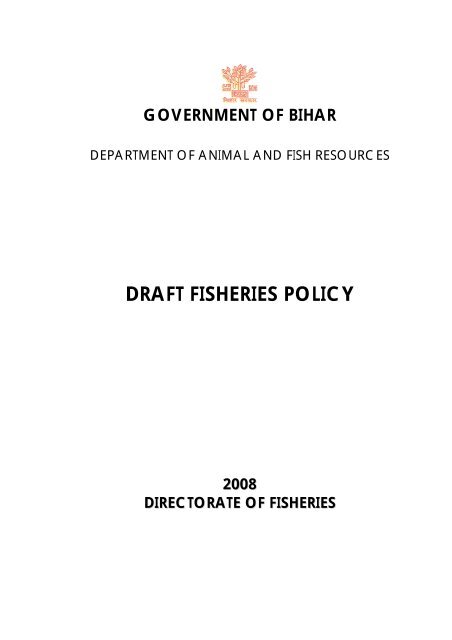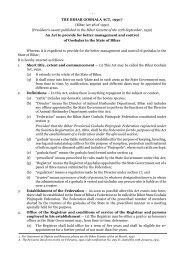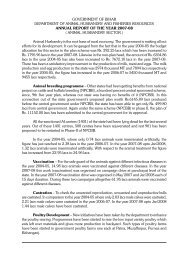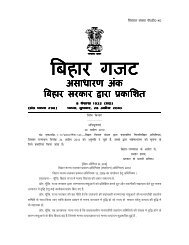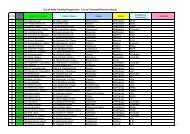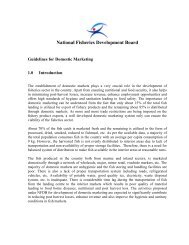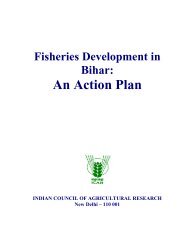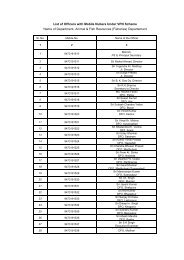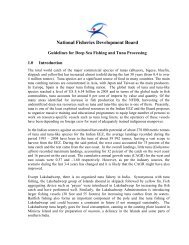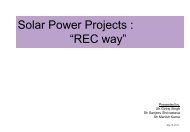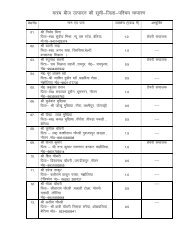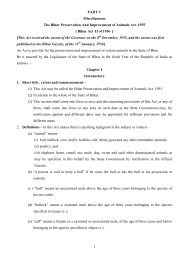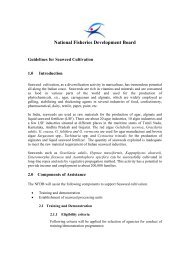GOVERNMENT OF BIHAR - Animal & Fish Resources
GOVERNMENT OF BIHAR - Animal & Fish Resources
GOVERNMENT OF BIHAR - Animal & Fish Resources
- No tags were found...
You also want an ePaper? Increase the reach of your titles
YUMPU automatically turns print PDFs into web optimized ePapers that Google loves.
<strong>GOVERNMENT</strong> <strong>OF</strong> <strong>BIHAR</strong>DEPARTMENT <strong>OF</strong> ANIMAL AND FISH RESOURCESDRAFT FISHERIES POLICY2008DIRECTORATE <strong>OF</strong> FISHERIES
<strong>Fish</strong>eries Policy 2008THE GOALDevelopment and management offisheries and aquaculture resources forproviding sustainable livelihoods to rural poorcommunities and overall economic growth ofthe State with due considerations toenvironmental well being, gender concerns,socio-economic and cultural aspirations of thepeople of Bihar with special attention to fishersand fish farmers.A knowledge driven developmentorganisation with dynamic, motivated andprofessional human resources that deliversquality extension services, co-managesresources with stakeholders, guides sustainableand equitable development, and is modern,accessible and accountable.2
<strong>Fish</strong>eries Policy 20081. Need and Rationale for <strong>Fish</strong>eries PolicyThe economy of Bihar is mainly dependent on agriculture, animalhusbandry and fisheries. <strong>Fish</strong>eries and aquaculture sector play a keyrole in food security and employment generation as significantproportion of population depend upon fisheries, aquaculture andallied activities for their livelihood sustenance and income. Besides, thesector also generates precious revenue for the State. The importanceof fisheries sector to the State economy has increased particularly afterthe creation of Jharkhand as a separate State. The State has twodistinct land masses on either side of the holy River Ganga and isdivided into 38 administrative districts, 21 in North Bihar and 17 in SouthBihar. Bihar, lying in the heart of Gangetic plain, is blessed with fertileland resources though extreme hot and cold climatic conditions alongwith flood and drought situations are characteristic part of thegeography.The State is endowed with rich aquatic and fisheries resources inthe form of rivers, flood plains, wetlands (chaurs), ox-bow lakes(mauns), reservoirs, tanks and ponds. The main culture fishery resourcesof Bihar lie in over 43,000 ponds and tanks of variable sizes covering atotal area of about 65,000 ha distributed throughout the length andbreadth of the State. Flood plains and other wetlands locally known aschaurs are other major fisheries resources and measure about 45,978ha which are found mainly in the basins of Kosi-Gandak river systems ofNorth Bihar. Estimate prepared by Irrigation Department indicateseveral fold higher figure. Ox-bow lakes, locally known as mauns, arethe discarded loops of meandering rivers which got cut off from themain rivers and is estimated to be about 9,000 ha. The 29 reservoirs inthe State covering total water spread area of about 11000 ha is animportant resource for fisheries development. Besides, 3200 km of riversare the main resource for capture based fisheries in the State.3
<strong>Fish</strong>eries Policy 2008The annual fish production of the State, both from aquacultureand capture fisheries, has been estimated at 0.261 million tons againsta demand of approximately 0.456 million tons. This has remainedalmost stagnant for many years. Evidently, there exists a wide gapbetween demand and supply, to the tune of 43%, which is quiteparadoxical in view of the vast fisheries resources in the State. Theunmet demand is partly met from supply of fish from other States.Similarly, the annual demand of fish seed in the State is over 900 million,while the production is only about 350 million from the 121 governmentfish seed farms, two corporate level fish hatcheries, and 26 privatehatcheries.On one hand the State has huge underutilized and untappedfisheries resources which offers immense potential for fish productionand scope for the development of rural livelihoods, while on the other,the state still depends for supply of about half of its demand of fish fromother states. The very low average productivity in all culture basedfisheries eco-systems, poor socio-economic condition of fishers and fishfarmers, lack of adequate public and private investment and capitalflow into fisheries sector, lack of awareness about aquaculture as aviable and profitable economic activity, non availability of adequateand professionally skilled human resource, ineffective and redundantservices delivery systems, poor infrastructure facilities, etc have all beenresponsible for the limited growth and development of fisheries sectorin Bihar. Thus there is an urgent need to bridge the gap betweendemand and supply of food fish and fish seed by effective andsustainable utilisation of available resources.However, a favourable legal and institutional environment needsto be created to meaningfully address these challenges in order toproduce adequate and cheap food fish for all and improve the qualityof life of fishers and farmers. A comprehensive and enabling fisheriesand aquaculture policy is a necessary prerequisite to provide overall4
<strong>Fish</strong>eries Policy 2008direction, develop appropriate strategies, support implementation ofdevelopment programs and mobilise resources for the full fledgedgrowth and development of fisheries sector. In the changing scenarioof globalisation and increasing market integration, a dynamic policy isvital to steer the fisheries sector through the higher growth trajectory bytapping the new opportunities and tackling the impending challenges.The overall objective of the fisheries and aquaculture policy shall be toincrease the fish production on a sustainable basis to ensure food andlivelihood security in the rural sector.Within this broader context, the specific objectives of <strong>Fish</strong>eriesPolicy are:1. To promote development and management of all fisheries andaquaculture resources to become a food and seed fish surplusState in an ecologically sound, economically viable and socioculturallycompatible manner2. To provide adequate, sustainable and equitable livelihood tofishers and fish farmers, and ensure availability of cheap andquality fish to all3. To generate entrepreneurial and employment opportunities, andfacilitate creation of necessary infrastructure facilities throughpublic and private investment in fisheries and aquaculture sector4. To conserve and manage the fisheries resources and fishbiodiversity for its sustainable utilisation5. To create wider social awareness about importance of fisheriesand aquaculture and promote consumption of fish aswholesome food6. To transform the Directorate of <strong>Fish</strong>eries into a professionalagency providing extension services to fishers, farmers and5
<strong>Fish</strong>eries Policy 2008entrepreneurs following a people centered approach todevelopment2. Data Gathering and Development PlanningTimely, complete and reliable statistics on potential resources, statusof utilisation, resource wise and species wise production andproductivity levels, catch and fishing effort, different socio-economicparameters and market information is essential for formulation ofrelevant policies, programs and action plans. At present, there is noestablished and fool proof system for systematic and regular collectionof data on fisheries in the State. Only crude estimations andapproximations with wide margins of error form the basis ofdevelopment planning and management.The policy envisages institutionalising a mechanism for systematiccollection, verification and updating of timely, complete and reliablestatistics on various physical, biological, economic and socialparameters of fisheries as per the nationally and internationally agreedformat. Involvement of various stakeholders particularly the producergroups will be strongly encouraged in both collection and verificationof various statistics. Measures are to be initiated for propercategorization, analysis, and wider dissemination of data thusgenerated and maintaining a computerised database for easyretrieval. Remote sensing and Geographical Information System wouldbe deployed for survey of various resources especially the open waterbodies to be followed by ground truthing.3. Development of Aquaculture in PondsTanks and ponds of water spread area less than 10 ha in sizesthat can be classified as ponds total an area of about 65,000 ha. Ofthese, about 22,000 ha are constituted by individual ponds of sizes lessthan 0.5 ha while about 26,500 number of water bodies with waterspread area between 0.5 and 10 ha constitute a cumulative water6
<strong>Fish</strong>eries Policy 2008spread area of 43,000 ha. Presently, aquaculture in ponds and tanksremains the main support for livelihood of the poor fish farmers in ruralareas. However, the productivity of ponds is only about 800 kg / hawhich is much below their potential of 3000-5000 kg/ha/year.Fragmented and small size of land holdings due to higher growth rateof population, heavy siltation and poor physical condition of ponds,and traditional culture practices have made the pond aquacultureremain as a subsistence activity.The policy proposes to bring aquaculture at par with agriculturein terms of credit, taxation, energy charges, water tariff and landallocation owing to the similarities between the two sectors in theresource use pattern, providing livelihood support to fishing andfarming households and further fisheries development in the State. Thepolicy envisages that all types of water bodies below 10 ha in size shallbe brought under improved scientific composite fish culture andachieve an annual average productivity of 3000 - 5000 kg / ha. This is tobe made possible by restoration and renovation of existing waterbodies, creation of new water bodies, imparting training onappropriate technologies, extension support and ensuring availabilityof all inputs and support services including credit facilities. Also, supportunder various schemes is to be mobilised for renovation of the Govt.ponds.4. Development of <strong>Fish</strong>eries in Ox-Bow LakesAn estimated 9,000 ha of water spread area varying in size from 4to 400 ha in the form of ox-bow lakes or mauns offers immense scopefor scientific culture based fisheries development supporting a sizeablenumber of fishers and small and marginal farming households. Theselakes are the discarded loops of meandering rivers, mainly in theGandak basin, which gets disconnected and connected with the mainrivers during floods or rainy season thereby drawing water. At present7
<strong>Fish</strong>eries Policy 2008mainly capture fisheries is practiced, and only about 2700 ha area i.e.less than one third of available area has been brought under culturewith average productivity of 300-400 kg/ha/yr. The lakes have beensubjected to a number of stress factors like heavy infestation of aquaticweeds, siltation, encroachment, habitat degradation, etc leading toconsiderable decline in its physical expanse and aquatic biodiversity.The policy seeks to bring almost every ox bow lake into culturebased fisheries by the year 2020 and produce nearly 9000 tons of fishproduction every year. The policy encourages community participatedmanagement of the ox-bow lakes by active involvement of localfishing / farming communities. The leasing policy shall ensure long termleasing of water bodies to facilitate investment, inculcate a sense ofownership and sustainable production approach. The leasing priority,lease rent, terms and conditions are to be streamlined and subjectedto periodic review. Cluster development approach is to be adopted toensure easy and round the year availability of adequate and qualityfish seed. Comprehensive mapping and survey for proper planning,renovation and restoration of oxbow lakes to make them suitable forfish culture, regular training and technical support are some of the mostessential part of the management strategy so as to help them theinvolved local communities sustainably manage these ecologicallysignificant resources.5. Development of <strong>Fish</strong>eries in Floodplains and WetlandsThe northeast part of Bihar has a long stretch of flood plains inGandak and Kosi basins. A series of shallow lakes locally known aschaurs exist in these areas to the tune of about 46000 ha. These waterbodies support a rich biodiversity, but are biologically sensitive andfragile in nature. They are also the repositories of variety of freshwaterfood and ornamental fishes. At present, a mainly capture fishery isbeing practiced with production being as less as 40 -50 Kg8
<strong>Fish</strong>eries Policy 2008per/ha/year. Greater colonization of macrophytes and habitatdegradation are also major problems. These water bodies, however,have shown high fish production to the tune of more than 1000kg/ha/year in certain well managed pockets. The property regime inthe floodplains is unique wherein many individual farmers own only partof the cropping land under submergence, making any culture andmanagement practice conditional upon collective effort of thefarmers. Some water spread areas cover land areas under both privateas well as State ownerships.The policy recognizes this unique property regime and envisagesco-operative / collective management of these water bodies whereincrop cultivation is integrated with fisheries (crop cultivation underindividual management while fish culture under collectivemanagement). Thus this policy visualizes cluster development of waterlogged areas for food and employment without altering the nature ofthe ecosystem. Since water logged areas have submerged landholdings of many farmers, community based collective / participatorymanagement would be the best and successful model ofdevelopment. Farmers would be mobilised for the same so as to reachmutual commitments and make shared and informed decisions whilereducing conflicts. This would minimize the uncertainty over resourceuse and finally farmers would share both the costs and benefits of theirefforts. Demonstration of the possibility and profitability of aquaculturein chaurs through pilot scale intervention, encouraging the involvementof NGOs for mobilising and organising the farmers, motivation andtraining to farmers, facilitating different models of contractual farmingarrangements, mobilising inputs, credit and marketing support underdifferent schemes shall be the major thrust areas to achieve anaverage productivity of 500 to 700 kg/year/ha.Recognising that the policy statement of Department of Water<strong>Resources</strong> ‘water logged areas like chaurs and flood plains should not9
<strong>Fish</strong>eries Policy 2008be drained out, rather they should be retained as it is and broughtunder fish culture’ would greatly benefit fisheries development,Department of <strong>Animal</strong> and <strong>Fish</strong> resources would work closely withDepartment of Water <strong>Resources</strong> and Department of Agriculture forintegrated development of floodplains.6. Development of <strong>Fish</strong>eries in ReservoirsAs in other states, reservoirs in Bihar are primarily for irrigationpurpose. These reservoirs are highly productive from the biologicalpoint of view as they get adequate light and optimum atmospheric /water temperature which are conducive for growth of fish. Reservoirs inBihar are relatively small having water spread area less than 1000 haeach. Present average fish yield is below 20 kg/ha/yr which is belowthe national average. The low yield of fish from reservoirs in Bihar areattributed to many factors including dependency on the rains and thecatchments for water, lack of quality yearlings for stocking,inappropriate use of gear and craft, improper management regime,and other institutional and management factors like ailng cooperatives,lack of appropriate policy, lack of fishing andmanagement rights to Department of <strong>Animal</strong> and <strong>Fish</strong> <strong>Resources</strong>, etc.The guiding principle of fisheries development in reservoir isproductivity enhancement coupled with livelihood development andrevenue generation. The policy proposes to transfer the fishing andmanagement rights of all reservoirs to Department of <strong>Animal</strong> and <strong>Fish</strong><strong>Resources</strong> for the purpose fisheries development. The policy givespriority of lease to the displaced / affected population and traditionalfishers by forming fishers’ co-operatives, fishers’ associations and SHGsas a means of their rehabilitation process. In their absence, the reservoirwill be leased out to the group of unemployed youth, privateentrepreneurs, public undertaking, etc through open auction. Leaseperiod will be long term of ten years within stipulated terms and10
<strong>Fish</strong>eries Policy 2008conditions based on revenue sharing and or fixed lease rent model.The lease amount is to be determined based on the productivity of thereservoir and the lessee at stake. An appropriate management plan foreach reservoir is to be evolved jointly by the Department and thelessee for promoting culture based fisheries under co-managementsystem to ensure optimum stocking with desired size and species ratioof seeds, introduction of appropriate fishing craft and gear,observance of closed season, efficient functioning of fishers’ cooperatives/ SHGs, facilitate marketing and ensure equity of benefits.The emphasis will be empowering the local fishing communities andtheir organisation so that they can effectively participate in themanagement of reservoir hand in hand with DoF.7. Seed ProductionQuality fish seed is the most critical input in aquaculture. Easyand round the year availability of adequate and quality fish seedthroughout the growing season at farm level is a determining factor infurthering aquaculture growth. The present seed production is about350 million while the demand is 600 million where the demand gap of250 million is met by supply from other States and natural collection (10-20%). There are two government run and 26 private hatcheries in theState besides 121 government fish seed farms most of which are nonfunctional.Lack of trained / skilled personnel in designing, constructionand operation of hatcheries, lack of adequate number of hatcheries,particularly in Eastern and Western parts of the State, issues ofencroachment, weed infestation, lack of reliable ground water supplyin most of Govt. seed farms, poor maintenance and management ofseed farms, depleting natural stock in rivers due to unregulated fishing,poor and inadequate transport facilities and a lack of mechanism forsupply chain management are the pertinent issues to be addressed.During the coming decade the State will be in need of over 1,00011
<strong>Fish</strong>eries Policy 2008million fingerlings which would require production of 8,000 millionspawn by 2020 so as to bring the potential area under aquaculture.The policy envisages following measures to holistically addressthe various issues. Revival of existing government fish seed farms andhatcheries through public private partnership mode with involvementof unemployed fisheries graduates and entrepreneurs, modernizationand renovation of all the seed farms, commissioning of 100 new privatecarp hatcheries in the State, creation of 500 ha of nursery and rearingspace in next five years and ultimately 650 ha by the end of the year2020 in both public and private sector, establishing at least one fishfarm and hatchery in each district under government and/ or privatesector, promotion through special schemes fish seed productionamong farmers and encourage group of seed growers in all majorpockets through special schemes to ensure easy and year roundavailability of quality fish seed of desired species at the farm level.8. Diversification of AquacultureBihar has enough potential for diversification of aquacultureactivities like introduction of freshwater prawn farming, culture of airbreathingfishes, ornamental fish culture and propagation ofornamental aquatic plants, integrated farming system, etc. The policyseeks to promote these activities.The giant freshwater prawn Macrobrachium rosenbergii (scampi)is a suitable species to be cultured in Bihar especially with carps.Entrepreneurs will be encouraged and supported to develop scampiseed hatcheries to meet the local demand of seed. Similarly, catfishespossess considerable commercial importance due to their highconsumer preferences and price. Clarias batrachus, Heteropneustesfossilis and Anabas testudineus are three of the most popular airbreathingcatfishes which are well adapted to the chaur ecosystem.12
<strong>Fish</strong>eries Policy 2008Adequate technical and financial support will be made available tofarners and entrepreneurs for establishing cat fish hatcheries forcommercial production of seed. Extension system will be strengthenedto popularize cat fish culture and ensure easy availability of cat fishseeds and popularize commercial production with annual additional0.5 to 2 tons of cat fish / ha.Important ornamental fishes like Chanda ranga, Chanda nama,Colisa fasciata, Colisa lalia, Gudusia chapra and others like sandloach, tiger barbs Puntius sps, etc. are found in chaurs and lakes.Specialized training programme for fisher and especially women shallbe arranged for identification and culture of ornamental fishes.Integrated fish farming will be encouraged wherein poultry, duckery,piggery, cattle rearing, floriculture, horticulture and food grainproduction will be integrated at the farm level to maximize the returnper unit land and water resources and minimize the cost. Properinterventions would be done to motivate farmers and convergedifferent schemes owing to different commodities for benefit offarmers. The concept of small-scale aquaculture is an importantelement of family farming system. A section of small fish inhabiting floodplains and ox-bow lakes are vanishing fast. Such fishes are consideredtrash / weed fishes under composite fish culture. Now they are found tofetch higher market price than carps. Efforts will be made to harnesssuch indigenous species by incorporating them in the fish productionprogram. Such an effort will also help protect the declining fishbiodiversity.9. Management of Riverine <strong>Fish</strong>eriesThe riverine resources consist of 3,200 km of rivers across the Stateand 1,00,000 ha of perennial riverine command area. Capture fisheriesis practiced to some extent with declining fish catch due to habitatdegradation, pollution of rivers upstream, use of destructive fishing13
<strong>Fish</strong>eries Policy 2008practices, exploitation of brooders and juveniles, etc. Many of the fishspecies which were very common in the past are not present in goodnumbers now. Further the mean size of many commercial species hasreduced over a period of time.Conservation based regulatory approach will be the guidingpolicy objective. The policy aims to reduce further degradation of theriverine ecosystem, conserve the aquatic resources and enhance theproductive capacity of the resource in the long term. Accordingly, theexisting guidelines related to fishing in rivers, licensing terms, prohibitionof destructive practices, etc will be reviewed, streamlined and strictlyimplemented. The local fishing communities, conservation orientedNGOs and other Community Based Organisations will be activelyinvolved in conservation and management of riverine resources. Selectstretches of rivers will be protected as sanctuaries. One fish will beidentified as a State <strong>Fish</strong> in order to create a wider social awarenessand inculcate conservation principles among the public.10. Conservation of Aquatic BiodiversityThe fish genetic resources of Bihar are represented by variety ofspecies. The State has a golden history of numerous aquatic faunawhich were abundant in the past. Man made interferences have nowchanged the scenario and many species which were abundant in thepast are now no where or on the verge of extinction. In this context it isnecessary to take serious steps for in situ conservation of fish diversity.Developing strategies for in situ conservation of native aquatic floraand fauna should be an important thrust area and efforts shall bemade to develop fresh water protected areas. Simultaneouslyrestricting the undesired exotic fauna of fishes is also necessary. Thoughprohibitory provisions have been made in Bihar Water-bodiesManagement (Amendment) Act 2007, awareness among people isalso important. Extension service system would be strengthened to14
<strong>Fish</strong>eries Policy 2008make people and farmers aware about the disastrous effects ofculturing undesired, exotic and banned species of fishes. Similarlyintroduction of unwanted exotic species in pond aquaculture isaffecting fisheries and if not prohibited will have a devastating effect.11. Leasing and Management of public water bodiesRevenue water bodies were transferred to <strong>Fish</strong>eries Departmentwith an aim to develop scientific aquaculture in them and to developthese water bodies with subsidy based credit from financing institutions.Due to interferences at various levels, inefficient extension deliverysystem and poor lending by bankers as well as fisheries co-operativesocieties the desired development was not achieved. This it calls for aholistic approach and multidimensional intervention to make fuller useof these water bodies for maximising fish production and over allbenefits of fishers. It also requires a sustainable managementapproach. The process of leasing shall also be transparent as well assensitive to all these aspects.Accordingly, the Bihar Water bodies Management Act 2006 withits Amendment in 2007 sought to address all these issues. The term‘fisherman’ has been defined as someone whose traditionaloccupation is fishing and fish culture so as to exclude the middlemenfrom leasing the Govt. ponds on priority. Also, categories of waterbodies for short term (five years) and long term (ten years) settlementare clearly defined. It prohibits fishing in the rivers between 15 th Juneand 15 th August, prohibits use of fishing net or gill net with mesh size lessthan 4 cm, prohibits use of dynamite or poison in rivers as well as pondswith penalties. Limitations and loopholes in the present system ofsettlement like discretionary powers of DFOs arbitrary application indeciding the period of lease, and revenue fixation, allotment of waterbodies to entrepreneurs / NGOs / SHGs etc, irregularities and litigationsin settlement would be addressed by suitable amendments. The15
<strong>Fish</strong>eries Policy 2008Department will critically monitor and review the performance andimpact of these Acts and accordingly revise the guidelines to achievethe stated policy objectives i.e. sustained higher production andfishers’ livelihood.12. Marketing and Value AdditionPeople of Bihar relish fish consumption in general. The everincreasingdemand for fish as food demands that apart from increasingfish production, the complete supply chain be efficiently managed tominimise post harvest losses, and maximize value for both the primaryproducers and final consumers.The policy aims at developing and maintaining a fast andreliable marketing network to reduce post-harvest spoilage, betterprice for fish producers besides creating gainful employmentopportunities. Federations of fisher co-operative societies, SHGs ofwomen and entrepreneurs would be motivated to establish cooperativemarketing network of skilled farmers, transporters andretailers. Organised modern hygienic wholesale and retail marketsexclusively for the fish with waste management facilities would beestablished with stakeholder participation across the State. Assistancewould be given for deep freezers, insulated vans, live fish careers andice plants as per norms. Special training courses would be designed topromote value addition of aquaculture products. Women SHGs wouldbe trained and financially supported for value addition of fish and theirmarketing. Wider public awareness will be created about fish as awholesome health food through mass media and publicity campaignsso as to increase fish consumption. Sale of fish and fish products on thepattern of SUDHA/Mother Dairy/PARAG by the <strong>Fish</strong> Federation is to beconsidered.16
<strong>Fish</strong>eries Policy 200813. Human Resource DevelopmentThe HRD in fisheries sector shall take into account the HRD offishers’ communities, farmers, Directorate of <strong>Fish</strong>eries staff, NGOs andother stakeholders involved in fisheries development. The technicalknow how as well as the managerial capabilities of these humanresources to be enhanced and strengthened. The present scenario ischarecterised by very low level of literacy, poor resource base, lack ofawareness and technical know how among fishers and farmers on theone hand and lack of adequate number of need based and skilloriented training programs at block and district levels on the other. Thepolicy proposes to provide field oriented training to alteast one lakhfishers and farmers on aquaculture, fisheries co-management, valueaddition and marketing to bring about major transformation in fisheriesdevelopment. Illustrated, detailed, step by step and easy to follow fieldguides on relevant aquaculture practices will be made availablewidely to fishers and farmers.The training and delivery mechanism at the State level is illequipped, both conceptually and logistically, to meet thesechallenges at present and requires major reforms. Inadequate andpoorly skilled staff at different levels, lack of motivation and desireamong the staff for field oriented work, lack of sufficient careerdevelopment opportunities and refresher training programs, absenceof effective monitoring mechanism and accountability, competingand or conflicting role of DFOs/FEOs as settlement officers andextension workers, absence of extension staff at the Block level, nonintegrationof the Engineering cell / staff within the Department, verypoor infrastructure are some of the systemic HR issues constraining thedevelopment process.Hence, the policy assigns high priority to all round humanresource development with adequate financial outlay andinfrastructural support. The recruitment policy is to be accordingly17
<strong>Fish</strong>eries Policy 2008reformed to recruit requisite number of professional fisheries graduatesfor developmental work. Career advancement shall be linked to theperformance evaluation. Sufficient promotional avenues andappropriate incentives coupled and accountability will be integral partof the policy. Need based short term and medium term refreshertraining programs shall become a continuous and in-built program forcapacity building and competency development of the staff atvarious level. The content of the training programs to include both thetechnical knowledge as well as the societal and managerial skills likecommunity organisation skills, participatory techniques,communication skills, team building skills, ability to work with NGOs /SHGs. Development management programs for senior officers, projectmanagement programs for middle level officers and technical trainingfor junior staff will be major focus. The State <strong>Fish</strong>eries Research Institutewill be strengthened and upgraded into <strong>Fish</strong>eries Research and TrainingInstitute to cater to the training needs of fishers, farmers and the fieldstaff.14. Extension Service Delivery and Support SystemStrengthening and reorientation of extension services deserveshighest attention to transform the Directorate of <strong>Fish</strong>eries into aprofessional service providing agency to fishers and fish farmers as wellas for effective implementation of various development projects andschemes. At present, the State fisheries department has becomepredominantly a desk oriented regulatory department instead of afield based and client oriented extension department.The policy recognises that it requires a major restructuring as wellas change of mind-set, and calls for a paradigm shift from the classictransfer of technology approach which is also mainly subsidy incentivedriven to participatory extension system wherein the potential andstrength of target group is harnessed for demand driven and effective18
<strong>Fish</strong>eries Policy 2008extension services delivery system. The extension system would bestreamlined to provide not just technical support but a bundle ofservices covering the entire value chain mobilisation of input supportincluding credit and insurance support, market information andlinkages, and coordinating social support services from various welfareand development agencies (Central / States / NGOs) for the clienteleof fisheries sector. Policy for incorporating travel support includingmeans of travel (motorcycle) shall be an integral part of anydevelopment package for the development of fisheries / aquaculture.Besides they also deserve adequate support in terms of fund andmeans for undertaking frequent travels.The policy also places emphasis on economic and socialempowerment of the fishers and farmers which in the long run wouldensure sustainability and equity. Realising that the public extensionmachinery alone can not be able to fulfill all the requirements, thepolicy proposes to make the progressive farmers and fishers as partnersand extension agents who would be more convincing among thefellow farmers. Also, provisions for creating and using paraprofessionals,NGOs, Community Based Organisations for effectiveservice delivery would be made. Commensurate with the envisagedresponsibilities for the Directorate of <strong>Fish</strong>eries, increased financial andexecutive autonomy would be accorded.The policy recognises the potential of Information andCommunication Technology (ICT) as a cost-effective and interactivemechanism for delivering relevant information and knowledge to thestakeholders. The staff will be trained on the use of ICT. In line with theNational e-Governance Plan and the proposed State Data Centre, theDepartment of <strong>Animal</strong> and <strong>Fish</strong> <strong>Resources</strong> will work closely with theDepartment of IT and NIC to gainfully harness ICT for effective servicedelivery. DoF will focus on creation of relevant content and updating itso as to derive maximum benefit from the proposed integrated models19
<strong>Fish</strong>eries Policy 2008of service delivery wherein all the agriculture, market, ruraldevelopment, and citizen related services and information will bebundled through a single ICT platform at the village level. The conceptof one stop aqua shops may be taken up on pilot scale anddemonstrated to the aspiring entrepreneurs/NGOs/Co-operatives. Thiswill improve easy access, save time, and reduce cost for farmers andfishers. The planned Aquarium House in Patna will become the centralhub.15. <strong>Fish</strong>ers Livelihood and WelfareThe socio-economic condition of fishers, small and marginalfarmers are very low with widespread poverty, low literary level, higherbirth rate and poor health standards. Availability and access to socialservices like primary health, sanitation, education, public distributionsystem, institutional credit and other extension services are very limited.Besides, high rate of indebtedness to local money lenders, alcoholismamong fishers, higher degree of occupational uncertainty and hazardare some of the major concerns. The majority of fishers in our State leada life at the subsistence level though it is not simply their profession, buta way of life. Not only fishermen but also the fisherwomen activelyinvolved in harvest and marketing activities are more vulnerable. Theirpersonal lives are subjected to fatal accidents causing death ordisabilities. <strong>Fish</strong> culture in Bihar is prone to flood as well as drought. Poorfishers are the worst affected one. Post flood situation is so precariousthat farmers are not in a position to invest on feed and seed from theirresources.The policy lays a special emphasis on improving the over all livingstandard of poor fishers and farmers, and to bring them above povertyline. Special attention shall be given to nearly 49.60 lakh population (asper GOI statistics-2003 kindly check the figures) of fishers towardsincreasing the per capita income of the family, compulsory primary20
<strong>Fish</strong>eries Policy 2008education to every child, housing, safe drinking water and otheramenities, and group accident insurance coverage to 2,00,000 activefishers, fishing gears, and aqua farms, etc. Registration of fishermen andissue of ID cards for fishers and their family members would be done asa mandatory measure. Effective and fast assistance would be ensuredfrom the Calamity Relief Fund, insurance companies and other suchinstitutions. The Department will coordinate mobilisation of all theresources to provide welfare services to fishing communities likehousing, drinking water facility, primary health care, compulsoryprimary education for all fishers’ children by 2012, community centres,etc. <strong>Fish</strong>er women and children would receive greater attention.16. <strong>Fish</strong>eries Co-operativesPresently, the co-operative societies are plagued by economicinefficiencies, absence of democratic processes, mismanagement andmisappropriation of benefits by the dominant few, lack of transparencyand accountability, etc. The policy is alive to the fact that activeinterventions are necessary to strengthen and restructure <strong>Fish</strong>eries CooperativeSocieties in order to make them as a democratic grass rootlevel engine of fisheries development, and ensure equity of benefitsparticularly to their poor fisher members.The policy strives to initiate following measures to ensure greaterdegree of accountability and equity: creating wider awareness aboutthe rights and responsibilities of members and democratization ofelection processes; all societies shall have joint account preferably innationalized banks; all members shall have photo ID cards and the listto be available for public scrutiny; incentives and awards to bestperforming societies based on over all production as well as socioeconomicparameters; power of registration of societies andsettlement of their disputes to be given to Dept. of <strong>Animal</strong> and <strong>Fish</strong><strong>Resources</strong> as in other neighbouring States of Madhya Pradesh, Uttar21
<strong>Fish</strong>eries Policy 2008Pradesh and West Bengal; All transactions only through cheque/DDand no cash transaction; extension of lease period based onperformance; and regular independent survey of socio-economicstatus of members about the impact of co-operative societies. Also,technical and promotional cells in apex fisheries federations shall bepromoted to bring professionalism in the fishers’ co-operatives andmake them main vehicles of promoting livelihood developmentthrough scientific aquaculture. Secretaries of co-op societies shall beminimum matriculate pass and preference will be given to fisheriesgraduates / persons having knowledge in fisheries. To encourageeducation among fisher communities, preference as office bearersshall be given to fishers whose children are school going or educated.Implementing provisions of RTI Act would get a priority focus.17. Effective Linkages and Coordination<strong>Fish</strong>eries and aquaculture development, being dependent onwater and land resources having multiple uses and demands, requireseffective linkage and co-ordination with many Departments like Water<strong>Resources</strong>, Agriculture, Co-operatives, Environment and Forests,Revenue, Command Area Development Authority, Energy etc. Also foreffective implementation of many schemes as well as for convergenceof funds interdepartmental co-ordination is vital. Weak and ineffectiveinterdepartmental co-ordination particularly at district level and belowis one of the crucial missing links throttling the harnessing of fullpotential.The policy seeks to institutionalise the linkages and coordinationwith relevant Departments at different levels. Revival of <strong>Fish</strong>eries cooperativesocieties and making them effective at grass root level willbe carried out by active coordination with the Department of Cooperation.Encroachment of govt. seed farms as well as other govt.land (ponds/tanks, water bodies) for housing, agriculture etc are to be22
<strong>Fish</strong>eries Policy 2008identified and recovered with the coordination of the concerned DM.Also, effective linkages and co-ordination with Departments of Water<strong>Resources</strong>, Revenue, Command Area Development Authority etc atDistrict and State levels would help map and update the database ofwater resources including their ownership, speedy implementation ofrenovation/civil works of ponds, chaurs and mauns. To ensure optimumavailability of water for aquaculture due to competing demand forwater resources particularly for irrigation, proper linkages andcoordination with Departments of Water <strong>Resources</strong>, and Agriculture atDistrict level through the DM who also acts as Chairman of FFDA wouldbecome essential. Conservation of native fauna and effective controlof pollution in open water bodies would be taken care of bycoordination with the Department of Environment and Forests.Various Plans, programs and funding like State Plans, Central Planoutlays, externally funded programs/projects, National <strong>Fish</strong>eriesDevelopment Board, Institutional funding etc shall be streamlined atstate level for optimum utilisation of funds and effectiveimplementation of programs. Similarly, linkages at district level wouldbe strengthened for convergence of funds available under differentschemes like Rastriya Sam Vikas Yojana, Mukhya Mantri Vikas Yojana,Rural Employment Guarantee Scheme etc and integrate them foroptimum and speedy utilisation for development. Linkages andcoordination with the State level Department of Institutional Financeand Program Implementation would ensure that fisheries andaquaculture are included in district credit plans, and are considered asa separate sub-sector for NABARD funding being routed through leadbanks in each district.23


